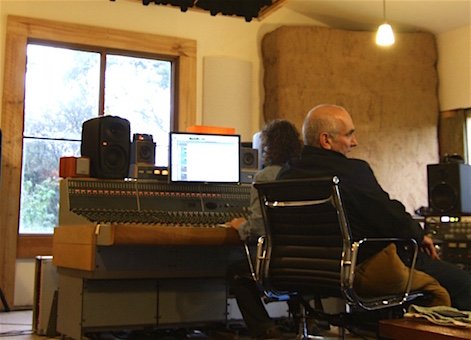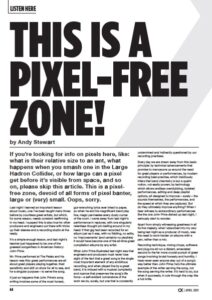News
25 Apr 2019
This is a Pixel-Free Zone

Subscribe to CX E-News
Listen Here
This is a Pixel-Free Zone
by Andy Stewart.
If you’re looking for info on pixels here, like: what is their relative size to an ant, what happens when you smash one in the Large Hadron Collider, or how large can a pixel get before it’s visible from space, and so on, please skip this article. This is a pixel-free zone, devoid of all forms of pixel banter, large or (very) small. Oops, sorry.
Last night I learned an important lesson about music, one I’ve been taught many times before by countless great artists, but which, for some reason, needs constant reaffirming in my head. I suspect this is also true for other producers and engineers out there with tricks up their sleeves and a recording studio at the ready.
It’s a simple enough lesson, and last night’s teacher just happened to be one of the greatest songwriters in American history: John Prine.
Mr. Prine performed at The Palais and his lesson was this: great performances are all about great players playing together, their sensitivity and skill on show for all to see, and for a singular purpose – to serve the song.
It just so happens that John Prine’s song writing involves some of the most honest, gut-wrenching lyrics ever inked to paper, so when he and his magnificent band play live, magic permeates every dusty corner of the room.
I came away from last night’s performance in raptures, with one singularly relentless thought pin-balling around in my head: if that gig had been recorded for an album just as it was, with no fiddling, no edits, no ‘improvements’ (and certainly no playlists) it would have become one of the all-time great compilation albums by any artist.
What John Prine illustrated last night was that engineers and producers must never lose sight of the fact that a great song is the single most important element of any ambitious recording, and when played live by a great band, it is imbued with a musical complexity and nuance that preserves the song’s life force – a self-evident cornerstone of the work we do, surely, but one that is constantly undermined and indirectly questioned by our recording practises.
Every day we are drawn away from this basic principle: by technical advancements that promise to manoeuvre us around the need for great players or performances, by modern recording best-practise, which insidiously infers that band chemistry is but a quaint notion, not easily proven; by technology which allows endless overdubbing, isolated performances, editing and deep playlist options, all designed to improve – surely – the sounds themselves, the performances, and the speed at which they are captured.
But do they ultimately improve anything?
When I bear witness to extraordinary performances like the one John Prine dished up last night, I seriously start to wonder. Apart from simply witnessing greatness in all its live majesty, what I absorbed into my very being last night as a producer of music, was the need to work harder on albums with a pen, rather than a mic.
Recording technique, mixing chops, software and plug-ins all run a distant, emaciated second to the far more crucial pursuit of great songs involving brutal honesty and humility. I have never seen anyone stay out of a song’s way better than John Prine; he’s the ultimate example of the writer serving the song, not the song serving the writer. It’s hard to do, but when it succeeds, it cuts through the crap like a hot knife.
Lessons From The Drawing Board
So how do we serve this principle better in our day-to-day lives in the recording studio? Well, it’s certainly not easy, but the first thing to do is be mindful of the fact that a lot of our choices as producers and engineers are self-serving.
We claim to be serving the song and the artist, but are we really? If we were brutally honest with ourselves, is it not possible that we are actually serving our preferred technique, rather than the song; the easiest recording option, not the song; or the least difficult, most convenient mixing chains, rather than the song? I suspect – in far more cases than we are prepared to admit – we are.
It’s an almost natural extension of our job, it seems – especially when we’re being paid to achieve a guaranteed outcome – that we become ‘solutions’ driven rather than musically curious, like the sonic equivalent of a bank’s obsession with risk aversion.
We find ourselves baulking at risky recording choices, the most obvious of which is putting six players in a room at once. In that situation, we often find ourselves saying things to the artist like: “It’s probably better for the song that we break this process down into overdubs, laid over a tempo map,” when, in truth, we might be simply be fearful of having a nervous breakdown that day trying to manage all those recording chains and headphone mixes, or achieving nothing if the band isn’t on its game.
Sure, it’s arguably riskier and more time consuming to wait for lightning to strike six people at once, but is the alternative really better? And if so, by what measure exactly?
Worse, our preference for overdubbing rather than live tracking might disingenuously stem from far more mundane fears, rather than considered, professional opinion. With six players in the room – assuming we can even fit them all in – we may not be able to scrounge together enough mics, stands, leads, patch cables and outboard gear to build that many recording chains.
Or our headphone system might have to then include our girlfriend’s ear buds, or that dodgy pair with the crumbling pads that turn the sides of your head black. We might not have enough decent converters if we’re recording digitally, or enough working channels if we’re rolling tape.
Whatever the hidden agenda is, we are often guilty of arguing for a process based, not on what’s best for the song, but rather, what is most convenient or comfortable for us. If that sounds arse about, that’s because it is!
Everything to do with great album production involves genuine honesty, not just the appearance of it.
It’s not enough to talk about it, or expect honesty from the artist if everyone on the other side of the glass is making up half-truths and bulldust just to save the embarrassment of admitting to a technical shortcoming.
When a producer or engineer does that they undermine the very process they claim to serve, slowly but surely weakening the artist’s faith in their musical process, and by inference, their performance.
When John Prine plays live, there is nothing between him and every listener’s innermost feelings. He tells stories that resonate inside you like a bell, stirring up emotions that you weren’t prepared to show in public (without a handkerchief). At that, he is a master, and if ever you’re lucky enough to be involved with an artist that gifted, try not to corrupt their process with recording options that are, in truth, more about what serves you and your studio’s technical limitations than what’s best for their songs.
The Dilemma
But to track a live band properly we need lots more gear, and far more physical space.
Decades ago now we lost most of the big studios that allowed bands to record as a group, to downsizing home recordists armed with ADATs and a few mics. It was a great pity in at least one respect: it wasn’t just the SSL consoles, fancy mics and great tape machines that made the big facilities awesome, it was their physical space and still air – room to track, room to move, room to play table tennis…
For me, more and more, a good recording facility is about spacious rooms that people can play in together. The real trick is being able to provide this space without going broke!
Andy Stewart owns and operates The Mill on Victoria’s Bass Coast. He’s a highly credentialed producer/engineer who’s seen it all in studios for over three decades. He’s happy to respond to any pleas for recording or mixing help… contact him at: andy@themill.net.au
From CX Magazine – April 2019
CX Magazine is Australia and New Zealand’s only publication dedicated to entertainment technology news and issues – available in print and online. Read all editions for free or search our archive www.cxnetwork.com.au
© CX Media
Lead image: The author and Paul Kelly in The Mill studio, photo courtesy Andy Stewart.
Subscribe
Published monthly since 1991, our famous AV industry magazine is free for download or pay for print. Subscribers also receive CX News, our free weekly email with the latest industry news and jobs.





